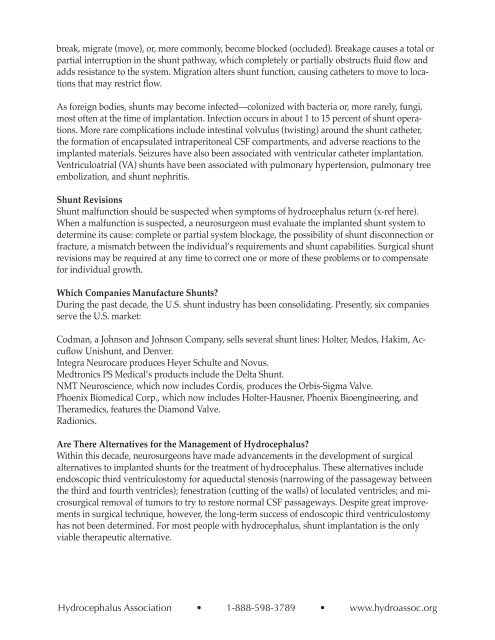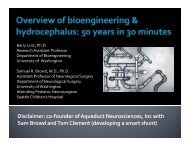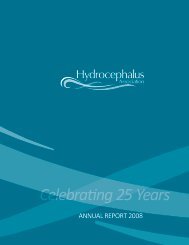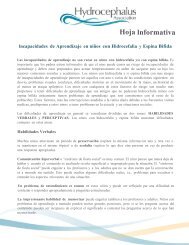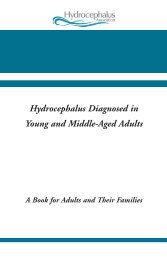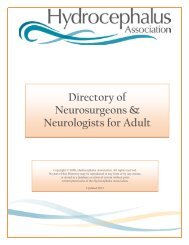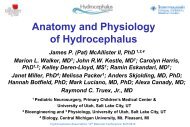Fact Sheet: Cerebrospinal Fluid Shunt Systems for the Management ...
Fact Sheet: Cerebrospinal Fluid Shunt Systems for the Management ...
Fact Sheet: Cerebrospinal Fluid Shunt Systems for the Management ...
You also want an ePaper? Increase the reach of your titles
YUMPU automatically turns print PDFs into web optimized ePapers that Google loves.
eak, migrate (move), or, more commonly, become blocked (occluded). Breakage causes a total or<br />
partial interruption in <strong>the</strong> shunt pathway, which completely or partially obstructs fluid flow and<br />
adds resistance to <strong>the</strong> system. Migration alters shunt function, causing ca<strong>the</strong>ters to move to locations<br />
that may restrict flow.<br />
As <strong>for</strong>eign bodies, shunts may become infected—colonized with bacteria or, more rarely, fungi,<br />
most often at <strong>the</strong> time of implantation. Infection occurs in about 1 to 15 percent of shunt operations.<br />
More rare complications include intestinal volvulus (twisting) around <strong>the</strong> shunt ca<strong>the</strong>ter,<br />
<strong>the</strong> <strong>for</strong>mation of encapsulated intraperitoneal CSF compartments, and adverse reactions to <strong>the</strong><br />
implanted materials. Seizures have also been associated with ventricular ca<strong>the</strong>ter implantation.<br />
Ventriculoatrial (VA) shunts have been associated with pulmonary hypertension, pulmonary tree<br />
embolization, and shunt nephritis.<br />
<strong>Shunt</strong> Revisions<br />
<strong>Shunt</strong> malfunction should be suspected when symptoms of hydrocephalus return (x-ref here).<br />
When a malfunction is suspected, a neurosurgeon must evaluate <strong>the</strong> implanted shunt system to<br />
determine its cause: complete or partial system blockage, <strong>the</strong> possibility of shunt disconnection or<br />
fracture, a mismatch between <strong>the</strong> individual’s requirements and shunt capabilities. Surgical shunt<br />
revisions may be required at any time to correct one or more of <strong>the</strong>se problems or to compensate<br />
<strong>for</strong> individual growth.<br />
Which Companies Manufacture <strong>Shunt</strong>s?<br />
During <strong>the</strong> past decade, <strong>the</strong> U.S. shunt industry has been consolidating. Presently, six companies<br />
serve <strong>the</strong> U.S. market:<br />
Codman, a Johnson and Johnson Company, sells several shunt lines: Holter, Medos, Hakim, Accuflow<br />
Unishunt, and Denver.<br />
Integra Neurocare produces Heyer Schulte and Novus.<br />
Medtronics PS Medical’s products include <strong>the</strong> Delta <strong>Shunt</strong>.<br />
NMT Neuroscience, which now includes Cordis, produces <strong>the</strong> Orbis-Sigma Valve.<br />
Phoenix Biomedical Corp., which now includes Holter-Hausner, Phoenix Bioengineering, and<br />
Theramedics, features <strong>the</strong> Diamond Valve.<br />
Radionics.<br />
Are There Alternatives <strong>for</strong> <strong>the</strong> <strong>Management</strong> of Hydrocephalus?<br />
Within this decade, neurosurgeons have made advancements in <strong>the</strong> development of surgical<br />
alternatives to implanted shunts <strong>for</strong> <strong>the</strong> treatment of hydrocephalus. These alternatives include<br />
endoscopic third ventriculostomy <strong>for</strong> aqueductal stenosis (narrowing of <strong>the</strong> passageway between<br />
<strong>the</strong> third and fourth ventricles); fenestration (cutting of <strong>the</strong> walls) of loculated ventricles; and microsurgical<br />
removal of tumors to try to restore normal CSF passageways. Despite great improvements<br />
in surgical technique, however, <strong>the</strong> long-term success of endoscopic third ventriculostomy<br />
has not been determined. For most people with hydrocephalus, shunt implantation is <strong>the</strong> only<br />
viable <strong>the</strong>rapeutic alternative.<br />
Hydrocephalus Association • 1-888-598-3789 • www.hydroassoc.org


